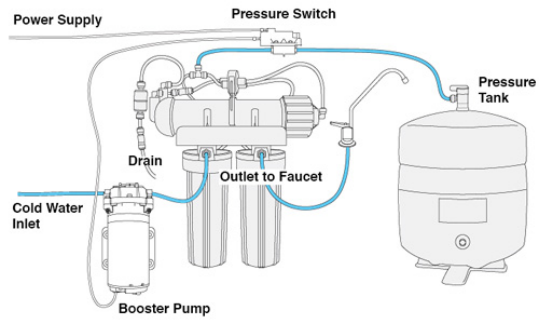A Reverse Osmosis (RO) system is one of the most effective water purification methods, removing up to 99% of contaminants. However, for the system to function efficiently, it requires optimal water pressure. If the pressure is too low, the filtration process slows down, reducing water production and affecting performance. This is where the RO booster pump plays a crucial role.
The RO booster pump helps maintain the proper water pressure, ensuring the system runs smoothly and efficiently. In this article, we’ll explore why an RO booster pump is essential, how it works, common issues, and tips for maintenance.
1. What is an RO Booster Pump?

An RO booster pump is a pressure-enhancing device that increases the incoming water pressure for an RO system.
How Does It Work?
✔ The pump pulls water from the main supply and increases the pressure before it enters the RO membrane.
✔ Higher pressure allows the RO membrane to filter water more efficiently.
✔ The pump is usually connected to a pressure switch, which turns it on and off automatically when needed.
The ideal pressure for an RO system is 40–60 psi (pounds per square inch). An RO booster pump is highly recommended if the pressure is below 40 psi.
Why is an RO Booster Pump Necessary?
Low water pressure reduces filtration efficiency, leading to slow water production and higher wastewater output. An RO booster pump solves these issues by:
Increasing Filtration Efficiency
✔ RO membranes work best at higher pressures (50–80 psi).
✔ A booster pump ensures the water passes through the membrane effectively, improving purification.
Reducing Water Waste
✔ Low pressure leads to higher wastewater production.
✔ By increasing pressure, the system produces more purified water while minimizing wastewater.
Enhancing Water Flow and Storage Tank Refill
✔ Without sufficient pressure, the RO tank fills very slowly.
✔ A booster pump speeds up water production and storage tank refilling.
Extending RO Membrane Lifespan
✔ High pressure prevents clogging and premature membrane failure.
✔ Reduces stress on other components, increasing system longevity.
Tip: If your RO system has low water flow or excessive wastewater, adding a booster pump can dramatically improve performance.
Common Issues with RO Booster Pumps & How to Fix Them
Although RO booster pumps are reliable, they may encounter issues over time. Here are some common problems and solutions:
Booster Pump Not Turning On
✔ Possible Causes:
- Faulty pressure switch.
- Loose or disconnected wiring.
- Power supply issues.
✔ Solution:
- Check and replace the pressure switch if necessary.
- Inspect wiring and ensure a proper power connection.
Pump Running Continuously
✔ Possible Causes:
- Faulty shut-off valve.
- Leak in the system causing constant pressure loss.
✔ Solution: - Check for leaks in the tubing or tank.
- Replace the auto shut-off valve if it is malfunctioning.
Low Pressure Even with a Booster Pump
✔ Possible Causes:
- Clogged pre-filters or RO membrane.
- Weak or failing booster pump motor.
✔ Solution: - Replace pre-filters and flush the RO membrane.
- If the pump is old, consider a replacement.
How to Maintain an RO Booster Pump for Long-Term Use
A well-maintained booster pump ensures consistent performance and a longer lifespan. Here’s how to take care of it:
✔ Check for Leaks & Unusual Noises – Inspect tubing and tighten loose connections.
✔ Clean the Pump Regularly – Dust and debris can affect the motor’s performance.
✔ Replace Pre-Filters on Time – Prevents clogging that reduces pressure.
✔ Monitor Pressure Readings – Ensure pressure stays within the recommended range (50–80 psi).
✔ Schedule Annual Servicing – Professional inspection helps detect hidden issues early.
Choosing the Right RO Booster Pump
When selecting a booster pump for your RO system, consider the following factors:
Compatible Pressure Rating
✔ Choose a pump that supports 40–100 psi, depending on your RO system’s needs.
Automatic vs. Manual Operation
✔ Automatic pumps turn on and off as needed.
✔ Manual pumps require switching on/off manually.
Pump Size & Flow Rate
✔ Ensure the pump matches the flow rate of your RO system (e.g., 50 GPD, 100 GPD).
Quality & Certification
✔ Look for NSF-certified pumps to ensure safety and reliability.
✔ Stainless steel components resist corrosion and wear.
Keep Your RO System Running Smoothly
An RO booster pump is essential for ensuring efficient water purification, reducing waste, and maintaining optimal system performance. By choosing the right pump and maintaining it properly, you can improve filtration speed, extend the lifespan of your RO membrane, and enjoy better water quality.
Key Takeaways:
✔ Improves water pressure for efficient filtration.
✔ Reduces water waste and increases purified water output.
✔ Prevents clogging and extends RO membrane life.
✔ Easy to maintain with regular checks and filter replacements.
✔ Choose a high-quality, compatible pump for the best performance.
? Looking for a reliable RO booster pump?
? Explore SANAKY’s premium RO booster pumps today!
? Need expert assistance? Contact us now!
----------------------------------------------------------------------------------
SANAKY VIETNAM., CO LTD- Manufacturer of Power, Distribution and Dry-type Transformer as well as RO Water Purifier, Chest Freezer - Upright Cooler, ...
☎ Hotline: (+84) 986 484 544
? hank@sanaky-vn.com
? www.sanaky-vn.com
 Vietnamese
Vietnamese  English
English  Chinese
Chinese  French
French  Spanish
Spanish  Russian
Russian  Arabic
Arabic  Portuguese
Portuguese